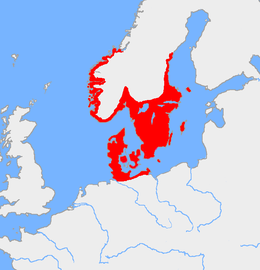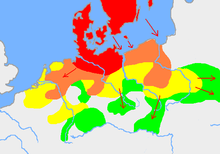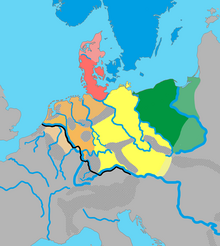
A | B | C | D | E | F | G | H | CH | I | J | K | L | M | N | O | P | Q | R | S | T | U | V | W | X | Y | Z | 0 | 1 | 2 | 3 | 4 | 5 | 6 | 7 | 8 | 9


Early Germanic culture was the culture of the early Germanic peoples. Largely derived from a synthesis of Proto-Indo-European and indigenous Northern European elements, the Germanic culture started to exist in the Jastorf culture that developed out of the Nordic Bronze Age. It came under significant external influence during the Migration Period, particularly from ancient Rome.
The Germanic peoples eventually overwhelmed the Western Roman Empire, which by the Middle Ages facilitated their conversion from paganism to Christianity and the abandonment of their tribal way of life. Certain traces of early Germanic culture have survived among the Germanic peoples up to the present day.
Languages



Linguists postulate that an early Proto-Germanic language existed and was distinguishable from the other Indo-European languages as far back as 500 BCE.[2]
From what is known, the early Germanic tribes may have spoken mutually intelligible dialects derived from a common parent language but there are no written records to verify this fact.
The Germanic tribes moved and interacted over the next centuries, and separate dialects among Germanic languages developed down to the present day.[3] Some groups, such as the Suebi, have a continuous recorded existence, and so there is a reasonable confidence that their modern dialects can be traced back to those in classical times.[4]
By extension, but sometimes controversially, the names of the sons of Mannus, Istvaeones, Irminones, and Ingvaeones, are sometimes used to divide up the medieval and modern West Germanic languages.[citation needed] The more easterly groups such as the Vandals are thought to have been united in the use of East Germanic languages, the most famous of which is Gothic. The dialect of the Germanic people who remained in Scandinavia is not generally called Ingvaeonic, but is classified as North Germanic, which developed into Old Norse. Within the West Germanic group, linguists associate the Suebian or Hermionic group with an "Elbe Germanic" which developed into Upper German, including modern German.[5] More speculatively, given the lack of any such clear explanation in any classical source, modern linguists sometimes designate the Frankish language (and its descendant Dutch) as Istvaeonic, although the geographical term "Weser–Rhine Germanic" is often preferred. However, the classical "Germani" near the Rhine, to whom the term was originally applied by Caesar, may not have even spoken Germanic languages, let alone a language recognizably ancestral to modern Dutch.[6] The close relatives of Dutch, Low German, English and Frisian, are sometimes designated as Ingvaeonic, or alternatively, "North Sea Germanic". Frankish, (and later Dutch, Luxembourgish and the Frankish dialects of German in Germany) has continuously been intelligible to some extent with both "Ingvaeonic" Low German, and some "Suebian" High German dialects, with which they form a spectrum of continental dialects. All these dialects or languages appear to have formed by the mixing of migrating peoples after the time of Julius Caesar. So it is not clear if these medieval dialect divisions correspond to any mentioned by Tacitus and Pliny. Indeed, in Tacitus (Tac. Ger. 40)[7] and in Claudius Ptolemy's Geography, the Anglii, ancestors of the Anglo-Saxons, are designated as being a Suebic tribe.[citation needed]
Despite their common linguistic framework, by the 5th century CE, the Germanic peoples were linguistically differentiated and could no longer easily comprehend one another.[8] Nonetheless, the line between Germanic and Romance peoples in central Europe remained at the western mouth of the Rhine river and while Gaul fell under Germanic domination and was firmly settled by the Franks, the linguistic patterns did not move much. Further west and south in Europe-proper, the linguistic presence of the Germanic languages is almost negligible. Despite the fact that the Visigoths ruled a kingdom in what is now Spain and Portugal for upwards of 250 years, there are almost no recognizable Gothic words borrowed into Spanish or Portuguese.[9] Conversely, many common given names in the Iberian peninsula, and the surnames derived from them, are of Germanic origin (Álvaro – Álvarez; Fernando – Fernández/Hernández; Gonzalo – González; Rodrigo – Rodríguez, etc.).[10]
By 500 CE, the West Germanic speakers had apparently developed a distinct language continuum with extensive loaning from Latin (due to their ongoing contact with the Romans), whereas the East Germanic languages were dying out.[b][2][11][c]
Literature

Germanic literature includes all the oral and written literature which was common to the early Germanic peoples, in respect to form and nature of content. It was generally intended to honor the gods or to praise tribal ancestors.[12]
The general public plays an insignificant role in Germanic literature, which revolves almost exclusively around chieftains, warriors and their associates. Wives and other female relatives of such leaders and warriors figure prominently in many pieces of Germanic literature.[12]
Germanic literature is divided into literature transferred orally from generation to generation and literature written down at a later date. Some of this literature, such as the Grottasöngr, appears to have been passed down from a very early time.[12]
Much of what is known about Germanic literature was passed down by skalds and scops, who were poets employed by a chieftain to memorize his deeds and those of his ancestors. Priscus notes that such skalds were also prominent at the court of Attila.[12]
The structure of the verse and the rime system shows that Germanic poetry followed a distinct poetic form. A significant characteristic is the alliterative verse.[12]
Riddles figure prominently in both Anglo-Saxon and early Scandianvian literature.[12]
Zdroj:https://en.wikipedia.org?pojem=Early_Germanic_festivals
Text je dostupný za podmienok Creative Commons Attribution/Share-Alike License 3.0 Unported; prípadne za ďalších podmienok. Podrobnejšie informácie nájdete na stránke Podmienky použitia.
Antropológia
Aplikované vedy
Bibliometria
Dejiny vedy
Encyklopédie
Filozofia vedy
Forenzné vedy
Humanitné vedy
Knižničná veda
Kryogenika
Kryptológia
Kulturológia
Literárna veda
Medzidisciplinárne oblasti
Metódy kvantitatívnej analýzy
Metavedy
Metodika
Text je dostupný za podmienok Creative
Commons Attribution/Share-Alike License 3.0 Unported; prípadne za ďalších
podmienok.
Podrobnejšie informácie nájdete na stránke Podmienky
použitia.
www.astronomia.sk | www.biologia.sk | www.botanika.sk | www.dejiny.sk | www.economy.sk | www.elektrotechnika.sk | www.estetika.sk | www.farmakologia.sk | www.filozofia.sk | Fyzika | www.futurologia.sk | www.genetika.sk | www.chemia.sk | www.lingvistika.sk | www.politologia.sk | www.psychologia.sk | www.sexuologia.sk | www.sociologia.sk | www.veda.sk I www.zoologia.sk
